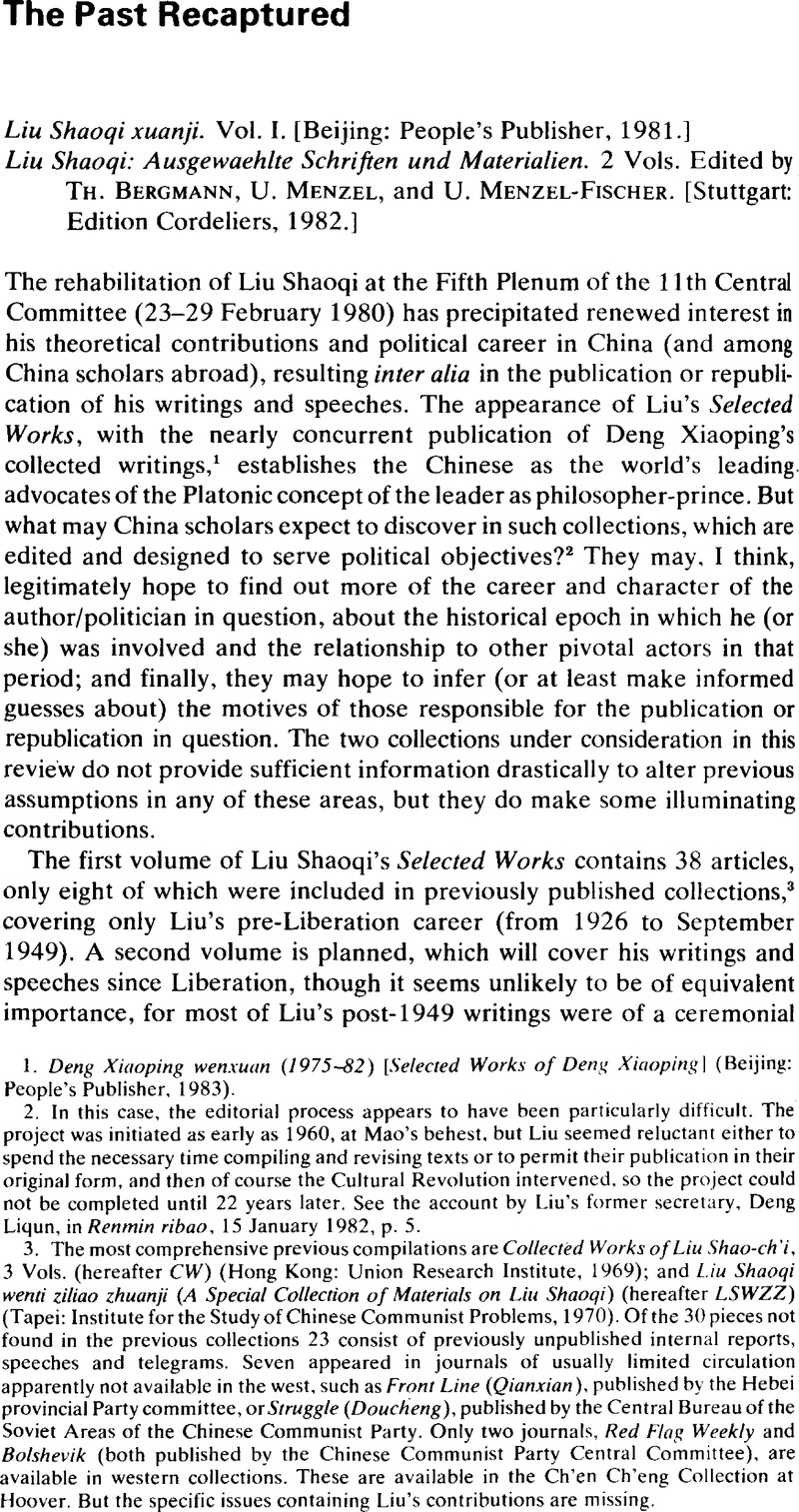
1. Deng Xiaoping wenxuan (1975–82) [Selected Works of Deng Xiaoping] (Beijing: People's Publisher, 1983)Google Scholar;
2. In this case, the editorial process appears to have been particularly difficult. The project was initiated as early as 1960, at Mao's behest, but Liu seemed reluctant either to spend the necessary time compiling and revising texts or to permit their publication in their original form, and then of course the Cultural Revolution intervened, so the project could not be completed until 22 years later. See the account by Liu's former secretary, Liqun, Deng, in Renmin ribao, 15 01 1982, p. 5Google Scholar;
3. The most comprehensive previous compilations are Collected Works of Liu Shao-ch'i, 3 Vols. (hereafter CW) (Hong Kong: Union Research Institute, 1969)Google Scholar; and Liu Shaoqi wenti ziliao zhuanji (A Special Collection of Materials on Liu Shaoqi) (hereafter LSWZZ) (Tapei: Institute for the Study of Chinese Communist Problems, 1970)Google Scholar; Of the 30 pieces not found in the previous collections 23 consist of previously unpublished internal reports, speeches and telegrams. Seven appeared in journals of usually limited circulation apparently not available in the west, such as Front Line (Qianxian), published by the Hebei provincial Party committee, or Struggle (Doucheng), published by the Central Bureau of the Soviet Areas of the Chinese Communist Party. Only two journals, Red Flag Weekly and Bolshevik (both published by the Chinese Communist Party Central Committee), are available in western collections. These are available in the Ch'en Ch'eng Collection at Hoover. But the specific issues containing Liu's contributions are missing.
4. “Regarding the principles of new China's economic construction.” June 1949, in Liu Shaoqi xuanji (hereafter LSX), p. 427.
5. “Criticizing the tactic of ‘withdrawing from the Yellow Trade Union,’” 18 January 1932, LSX p. 18.
6. “But our comrades should not repeat this general task and general strategy everyday in all documents like the Gospel,” he admonishes in a critique of “empty talk.” “Instead, our comrades should concentrate on local issues and problems and be more practical.” “Eliminating the leading style of empty talk,” 15 July 1936, LSX, p. 43.
7. “Adopting new attitudes towards new labour,” 20 May 1934, LSX, pp. 19–23. Although not published until 1934, an editorial note on p. 19 explains that this article was written for workers in the revolutionary base area in the winter of 1932.
8. On the Returned Student leadership and their errors, see “Eliminating closeddoorism and adventurism,” 10 April 1936, LSX, pp. 23–33; on United Front policy, see “Leadership is the central issue of the national United Front,” 20 November 1936, “Fighting for national democratic unification and the Party's leadership in the United Front,” May 1937, LSX, pp. 46–54 and 72–79, respectively. Compare with ”The question of independence and initiative within the United Front,” 5 November 1938, in Selected Works of Mao Tse-tung (Peking: Foreign Languages Press, 1965), Vol. II, pp. 213–19Google Scholar; An example of co-ordinated policy intitiative may be found by comparing “On new democracy,” January 1940, and “New-democratic constitutional government,” 20 February 1940, in Selected Works, Vol. II, pp. 339–85, and 407–417Google Scholar; and Liu's, “On anti-Japanese democratic power,” 12 1940, LSX, pp. 90–93Google Scholar;
9. “Report on current political problems (i.e. On the new phase of peace and democracy),” in LSWZZ, pp. 182–85.
10. “Our task and strategic deployment at present,” 19 September 1945, and “Use our main force to establish East, North and West Manchurian bases,” November–December 1945, consisted of telegraphs to leading comrades in the North-east Bureau. LSX, pp. 373–76.
11. “Chairman Mao has rested for a month and is still resting, because of fatigue,” Liu, wrote on 24 12 1945. LSX, p. 374Google Scholar;
12. “On changing slogans,” 5 October 1928, LSX, pp. 10–13.
13. “Party and mass work in the white areas,” May 1937, LSX, pp. 59–60.
14. “Adopting new attitudes,” LSX, p. 20.
15. “Adopting new attitudes,” LSX, pp. 21–22.
16. See Shaoqi, Liu, Three Essays on Party Building (Beijing: Foreign Languages Press, 1980)Google Scholar; The essays are, of course, “How to be a good communist,” “On inner-Party struggle,” and “On the Party.”
17. “Concerning the principles of new China's economic construction,” June 1949, LSX, pp. 428–29.
18. “Strengthen the great unity of the people of the whole country,” 21 September 1949, a speech made at the First Plenary Session of the CPPCC on behalf of the Chinese Communist Party. LSX, pp. 434–35.
19. LSWZZ, pp. 188–89.
20. This episode has been however discussed with apparent candour in the press. See for example the Theoretical Research Office of the Propaganda Department of Tianjin Municipal CCP Committee, “Reread comrade Liu Shaoqi's ‘Speeches in Tianjin,’” Renmin ribao, 21 04 1980, p. 5Google Scholar;
21. LSWZZ, pp. 134–42.
22. “Party and mass work,” LSX, pp. 66–68.
23. “Address to the 1957-class graduates of the Peking Institute of Geology,” 05 1957, CW, Vol. II, p. 424Google Scholar;
24. “A talk with journalists from North China,” 2 October 1948, LSX, pp. 405–406.
25. See for example Luther, Joerg-Michael, Liu Shaoqi's umstrittenes Konzepl zur Erziehung von Parteimitgliedern (Hamburg: Mitteilungen des Instituts fur Asienkunde, No. 100, 1978)Google Scholar;
26. Originally published in Amerasia (New York), 06 1947, pp. 161–64Google Scholar;
27. Liu Shaoqi: Ausgewaehlte Schriften und Materialien, Vol. I, p. 24.
28. Liu was in any case probably recruited by the outgoing Li Lisan rather than by Wang Ming. He had worked closely with Li at Anyuan.
29. See Guotao's, Zhang “Introduction,” in CW, pp. vi–viiiGoogle Scholar;
30. Liu Shaoqi, Vol. II, p. 326.